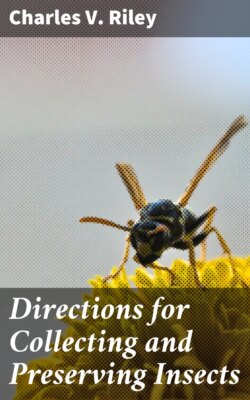Читать книгу Directions for Collecting and Preserving Insects - Charles V. Riley - Страница 6
На сайте Литреса книга снята с продажи.
CHARACTERISTICS OF INSECTS.
ОглавлениеTable of Contents
The term “insect” comes from the Latin insectum, and signifies “cut into.” It expresses one of the prime characteristics of this class of animals, namely, that of segmentation. This feature of having the body divided into rings or segments by transverse incisions is possessed by other large groups of animals, and was considered of sufficient importance by Cuvier to lead him, in his system of classification, to group with Insects, under the general term Articulata, Worms, Crustacea, Spiders, and Myriapods. Worms differ from the other four groups in having no articulated appendages, and in having a soft body-wall or integument instead of a dense chitinous covering, and are separated as a special class Vermes. The other four groups of segmented animals possess in common the feature of jointed appendages and a covering of chitinous plates, and are brought together under the term Arthropoda. The division of the body into a series of segments by transverse incisions, characteristic of these animals and these only, justifies the use of Cuvier's old name, Articulates, as this segmented feature represents a definite relationship and a natural division—as much so as the vertebral column in Vertebrates. The Cuvierian name should be retained as a coördinate of Vertebrates, Molluscs, etc., and the terms Vermes and Arthropods may be conveniently used to designate the two natural divisions of the Articulates.
The term “insect” has been employed by authors in two different senses—one to apply to the tracheated animals or those that breathe through a system of air tubes (tracheæ), comprising Spiders, Myriapods, and insects proper or Hexapods,[1] and the other in its restricted sense as applied to the Hexapods only. To avoid confusion, the latter signification only should be used, and it will be thus used in this article.
We see, then, that insects share, in common with many other animals, the jointed or articulated structure. Wherein, then, do they differ? Briefly, in having the body divided into thirteen joints and a subjoint, including the head as a joint, and in the adult having six true, jointed legs, and usually, though not always, wings. The five classes of Articulates differ from each other in the number of legs they possess in the adult form, as follows: Hexapoda, 6 legs; Arachnida, 8 legs; Crustacea, 10–14 legs; Myriapoda, more than 14 legs; Vermes, none. This system holds for the adult form only, because some mites (Arachnida) when young have only 6 legs, and many true insects in the larva state either have no legs at all, or have additional abdominal legs which are not jointed, but membranous, and are lost in the perfect or adult state. These are called false or prolegs.
It will serve to make these instructions clear if I at once explain that the life of an insect is marked by four distinct states, viz., the egg, the larva, the pupa, and the imago, and that the last three words will constantly recur. We have no English equivalent for the words larva and pupa, for while some authors have written them with the terminal e, so as to get the English plural, yet “larves” and “pupes” so shock the ear that the terms have not been (and deserve not to be) generally adopted.
We have seen that an insect in the final state has six true legs. Yet even here many species depart from the rule, as there are many in which the perfect insect, especially in the female sex, is apodous or without legs, just as there are also other cases where they are without wings. Sometimes the legs seem to be reduced in number by the partial or total atrophy of one or the other pair, but in all these exceptional cases there is no difficulty in realizing that we have to deal with a true insect, because of the other characters pertaining to the class, some of which it will be well to allude to.
Insects are further characterized by having usually three distinct divisions of the body, viz.: head, thorax, and abdomen, and by undergoing certain metamorphoses or transformations. Now, while a number of other animals outside of the insect world go through similar transformations, those in the Crustacea being equally remarkable, yet, from the ease with which they are observed and the completeness of the transformations in most insects, the metamorphoses of this class have, from time immemorial, excited the greatest curiosity.
Footnote:
[1] From the Greek εξαπους, having 6 feet.
